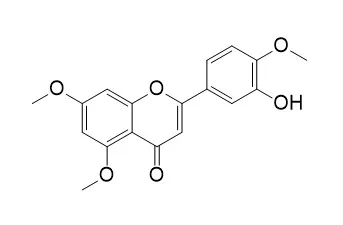| In vitro: |
| J Pharm Pharmacol . 2015 Apr;67(4):597-604. | | Zeyheria montana Mart. (Bignoniaceae) as source of antioxidant and immunomodulatory compounds with beneficial effects on intestinal inflammation[Pubmed: 25556766] | | Objectives: Zeyheria montana is a medicinal plant used in Brazilian folk medicine for treating skin affections, ulcers, inflammation and diarrhoea, and as an antisyphilitic and antiblenorrhagic agent, but little is known about its mechanisms of action. Herein, a bio-guided assay was carried out to further evaluate its antioxidant and immunomodulatory effects, and the possible benefits on experimental intestinal inflammation.
Methods: Extracts, partitions, fractions and isolated compounds were tested for inhibition of lipid peroxidation. Isolated compounds were tested in vitro for its antioxidant and immunomodulatory action prior to in-vivo evaluation in trinitrobenzenesulfonic acid-induced rat colitis.
Key findings: Two major compounds were identified in the leaf dichloromethane extract: 3'-Hydroxy-5,7,4'-trimethoxyflavone and 6-hydroxy-5,7-dimethoxyflavone, which exhibited an antioxidant activity. The compounds protected the colonic glutathione levels in more than 90% despite the absence of protection against the gross macroscopic colonic damage. In addition, the compounds inhibited IL-1ß secretion by macrophages in 91.5% and 72.7% respectively, whereas both reduced IL-6 secretion in about 44.5%.
Conclusions: The major active compounds from Z. montana leaves exerted antioxidant and immunomodulatory effects, endorsing the use of Z. montana in folk medicine as an anti-inflammatory agent. However, further investigation is still needed regarding medicinal plants and the identification of candidate compounds for the treatment of the inflammatory bowel diseases. | | Zhongguo Zhong Yao Za Zhi . 2016 Mar;41(5):868-873. | | [Studies on flavonoids from Cirsium setosum][Pubmed: 28875641] | | To investigate the chemical constituents of ethyl acetate from Cirsium setosum, fifteen flavonoids were obtained by column chromatography on silica gel, MCI, Sephadex LH-20, and preparative HPLC. Their structures were identified as 4',5,6-trihydroxy-7-methoxyflavone(1), 4',5-dihydroxy-7,8-dimethoxyflavone(2), sorbifolin-6-O-β-glucopyranoside(3), kaempferol-7-O-α-L-rhamnoside(4), kaempferol(5), quercetin-3-O-β-D-glucosyl-7-O-α-L-rhamnoside(6), myricetin(7), myricetin-3-O-β-D-glucoside(8), 5,7- dihydroxy -3',4'- dimethoxyflavone(9), 3',4',5- trihydroxy-3,7-dimethoxyflavone(10), 3',3,4',5-tetrahydroxy-7-methoxyflavone(11), 3'-hydroxy-4',5,7-trimethoxyflavone(12), 7-hydroxy-3',4',5-trimethoxyflavone(13), 4',5-dihydroxy-2',3',7,8-tetramethoxylflavone(14), and 5-hydroxy-2',3',7,8-tetramethoxylflavone(15) by spectroscopic data analysis. All compounds were isolated from this plant for the first time.Compounds(1-15) were evaluated for their hypoglycemic activities by PTP1B enzyme model. Among them, compounds 2, 12, and 14 showed significant PTP1B inhibitory activities with IC₅₀ values of 2.54, 1.85, 2.11 μmol•L⁻1, respectively. | | Phytochemistry . 2001 May;57(1):57-64. | | Insecticidal flavaglines and other compounds from Fijian Aglaia species[Pubmed: 11336261] | | Bioassays with lipophilic crude extracts of four Fijian Aglaia species against Spodoptera littoralis displayed strong insecticidal activity for A. basiphylla and A. gracilis, whereas A. archboldiana and A. vitiensis did not have any significant effects. The insect toxicity of A. basiphylla was caused by the well known benzofuran flavaglines rocaglamide, desmethylrocaglamide and aglafoline. In contrast, A. gracilis contained four related pyrimidinone derivatives in the root and stem bark, including two new congeners named marikarin and 3'-hydroxymarikarin. Moreover, two new putrescine bisamides, secoodorine and secopiriferine, a new benzopyran flavagline. desacetylaglain A. and a new norsesquiterpene were isolated from the leaves together with three known bisamides and 3-hydroxy-5,7,4'-trimethoxyflavone. The structures of the new compounds were elucidated by spectroscopic methods. Comparative feeding assays within the active pyrimidinone flavaglines showed that the free hydroxy group in aromatic ring A of marikarin diminishes insecticidal activity. | | Biochem Res Int . 2020 Feb 18;2020:4812312. | | Methylated Flavonols from Amomum koenigii J.F.Gmel. and Their Antimicrobial and Antioxidant Activities[Pubmed: 32148963] | | Methylated flavonols form a special group with modulating biological activities in comparison with kaempferol and quercetin. The present study isolated ten compounds including two kaempferol methyl ethers: 5-hydroxy-3,7,4'-trimethoxyflavone (1), 3-hydroxy-5,7,4'-trimethoxyflavone (6); four quercetin methyl ethers: retusin (5-hydroxy-3,7,3',4'-tetramethoxyflavone) (4), 3,5-dihydroxy-7,3',4'-trimethoxyflavone (5), 3,4'-dihydroxy-5,7,3'-trimethoxyflavone (7), and 3,5,7,3',4'-pentamethoxyflavone (9); β-sitosterol (2); 5-hydroxy-1-(4'-hydroxyphenyl)eicosan-3-one (3); p-hydroquinone (8); and vanillic acid (10) from the rhizomes and fruit of Amomum koenigii J.F.Gmel. (Zingiberaceae). Their structures were determined by MS, NMR, and X-ray spectroscopic techniques. Among the methylated flavonols, 1, 4-7, and 9 were isolated for the first time from the rhizomes, while 1, 4, and 5 were isolated from the fruit. Compounds 2, 3, 7, 8, and 10 were reported for the first time from the species. Three main methylated flavonols 1, 4, and 5 were quantitatively analyzed in the rhizomes of A. koenigii by RP-HPLC-DAD; their contents were determined to be 1.81% (1), 1.38% (4), and 1.76% (5). The antimicrobial assay against Escherichia coli, Pseudomonas aeruginosa, Bacillus subtilis, Staphylococcus aureus, Aspergillus niger, Fusarium oxysporum, Candida albicans, and Saccharomyces cerevisiae and antioxidant DPPH scavenging test were performed for the isolated methylated flavonols. |
|






 Cell. 2018 Jan 11;172(1-2):249-261.e12. doi: 10.1016/j.cell.2017.12.019.IF=36.216(2019)
Cell. 2018 Jan 11;172(1-2):249-261.e12. doi: 10.1016/j.cell.2017.12.019.IF=36.216(2019) Cell Metab. 2020 Mar 3;31(3):534-548.e5. doi: 10.1016/j.cmet.2020.01.002.IF=22.415(2019)
Cell Metab. 2020 Mar 3;31(3):534-548.e5. doi: 10.1016/j.cmet.2020.01.002.IF=22.415(2019) Mol Cell. 2017 Nov 16;68(4):673-685.e6. doi: 10.1016/j.molcel.2017.10.022.IF=14.548(2019)
Mol Cell. 2017 Nov 16;68(4):673-685.e6. doi: 10.1016/j.molcel.2017.10.022.IF=14.548(2019)